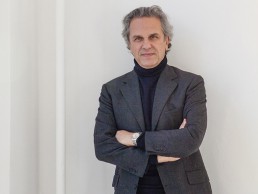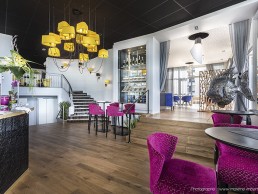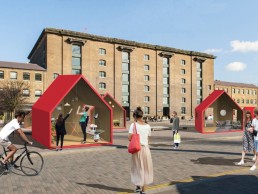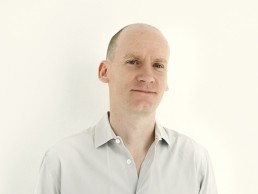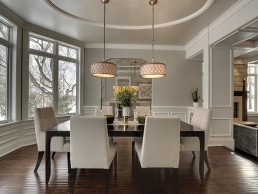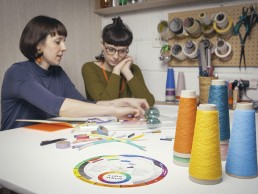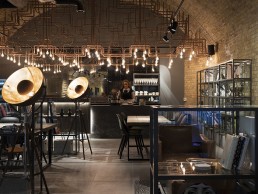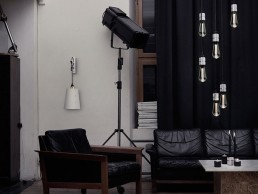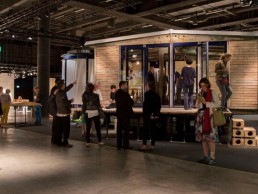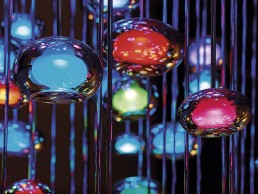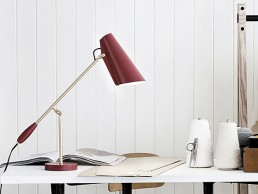Patrick Naggar
Born in Egypt, Patrick Naggar grew up in Paris, France in a family of art collectors. Exposed to modern art by his family from a young age, Naggar was often surrounded by influential creatives who played a part in shaping his creative thinking, in ways that he now employs in lighting design.
Visiting art studios and museums with family and friends such as Portuguese painter Vieira da Silva and British playwright Stephen Poliakoff, Naggar was destined for art and design from the beginning and went on to study architecture at the Ecole des Beaux-Arts in Paris.
“I considered architecture to be vital knowledge within art, interior and furniture design and held in high regard the way Italians view architects as being equally capable of designing interior spaces and products,” Naggar tells darc.
While studying in Paris, Naggar undertook an internship with an architect known for several luxurious buildings in Paris. Under the architect’s guidance, the budding designer was exposed to an array of craftsmen and skills of the French Arts Decoratifs movement in the 1930’s. “I resented it at the time as I was eager to be modern,” he admits, “but I realise today how important and instructive that training was – learning to design typical facades by hand with the correct orders and proportions.”
Having now developed a mature outlook based on his extensive training and experience, Naggar does not attempt to distinguish between ancient and modern and instead focuses on the difference between good and bad architecture. Aspiring to an international range of artistic figures such as Louis Kahn from the US to English architects such as David Chipperfield, Naggar aims to bridge the gap between classical and modern in his work. “I think the more modern we are, the more memory we need. There is nothing like a tabula rasa.” Seeking to connect areas that are usually kept apart, the French artist purports that humans are simultaneously ancient and modern and looks to cultivate hybrid and at times ambiguous designs.
This philosophy is seen in Naggar’s work from the beginning of his achievements in lighting design. Prior to the designer’s first work with Veronese ten years ago, he was invited to work with the CIRVA (International Centre for Glass Research) in Marseille, France. Here he designed an object representing Psyche, the Goddess of the soul in Greek mythology, which was a glass drop filled with water and illuminated with a small LED. With Veronese, a French manufacturer established in Paris in 1931, the company prides itself on its skills in the formation of luxury Murano glass lighting fixtures crafted in the tradition of French design. Naggar’s work with CIRVA joined harmoniously with his future work for Veronese in his drive to create hybrids between science, art, traditional and modern technologies. “The Drop series with Veronese is an avatar of this initial project with CIRVA inspired by Greek mythology,” explained Naggar. Inspired from the same source, the organic shape of Drop has been adapted as a table and wall lamp available in several colours evoking a light of myth and poetry to fill an interior.
Naggar’s most recent projects with Veronese have more of a scientific influence, such as the Orbe lamp for Veronese, taking the shape of the galaxy in wall sconces and table lamps. Most notable of his pieces blurring the boundaries between art and science is the Chromosome chandelier inspired by the DNA of a chromosome X, made by Veronese exclusively for display at furniture and lighting showroom Ralph Pucci International in New York.
“I was interested in translating an essential part of the human cell, one that carries information into an object with poetic license,” explained Naggar. “The double-coiled strands of DNA are materialised by fibre optics, which in the chandelier are represented by the light.” This chandelier exemplifies Naggar’s drive to create hybrid designs between tradition and modernity. The Murano hand blown glass shows how a traditional skill can be associated with a modern means of lighting. “Melding the traditional skill of glass blowing with a new way of using fibre optics is a new concept that introduces a new direction in lighting.”
With these creations in his arsenal, Naggar reflected on his time so far working with Veronese: “It has been a wonderful experience. This venerable house, which has produced works with French designer Andre Arbus and others since the early 1930’s, represents traditional Venetian glasswork while being open to exploring new avenues in design. It is a great artisanship rooted in history combined with a sense of innovation.” A match in theory and practise, Veronese has been a driving force in Naggar’s attraction towards lighting design. According to Naggar, lighting is the domain that has evolved the most in design recently, with new ways of using light to create ambiance and a strong symbolic value attached to it. This symbolism is what attracts him to lighting design the most, as it is after all the extinction of darkness.
Le Shore, France
Designheure provides a playful and colourful setting to a seaside luxury brasserie, where guests dine beside lapping waves and cockle shells.
What was once a practical, old-fashioned building housing a bookshop, tourist office, post office and even a radio station, now serves as a place of luxury for those looking to dine amongst design. Entirely redesigned by Jérémie Airiau of architectural design firm ADE Architecture based in Nantes, France, Le Shore is a seafront brasserie on the embankment of La Baule.
Aiming to surprise with the restaurant’s unique positioning and inviting atmosphere, restaurant owner Yves Guérin worked closely with the architectural team to redesign the building. “We had a precise idea of what we wanted to achieve,” said Airiau, “aiming to redesign the building into several spaces, including a bar, a brasserie, a teahouse and a library.”
Initially drawn to the project for Guérin’s meticulous and thoughtful vision, Airiau was then sold on Le Shore for how its interior design and lighting could interact with the restaurant’s stunning sea views. “The lighting was essential on this project from the beginning,” said Airiau. “The main challenge was to use lighting to create different spaces. The client wished for natural daylight, with a more intimate and romantic light for the evening. So all lighting was installed with a dimmable system to allow a change of atmosphere in each space.”
Starting with Designheure’s Nuage collection, guests are greeted in the entrance by a delicate yet prominent lighting scheme, a specific request from Guérin. “The Nuage collection was perfect for this,” said Airiau. Comprised of three pieces from this collection, the yellow Moyen 15 chandelier in front of the stairs gives off a golden glow, with deep yellow shades standing strong among loops of steel cables. This statement piece creates a conversation with the Nuage Petit wall lamps that appear next to the staircase with the same coloured shade, with Petit pendant lamps are also used elsewhere in the restaurant. Also from this collection, Nuage Grand 122 floor lamps feature in a yellow more similar to its adjacent seating area, bringing lighting and furniture together while adding more direct illumination closer to the dining tables.
A main lighting feature consistent throughout the restaurant is Designheure’s Petit Cargo suspension lamps. These work well to draw each space together with a neutral white that makes a statement through its bold design and black outlines. Each dining area takes on a different colour scheme that relates to its seaside surroundings, and the lighting works to exaggerate these colours and emphasise the relationship. “The Cargo collection is like being in a boat, as it illuminates the room in front of the sea,” said Airiau. “Sometimes we feel we’re in an imaginary universe, underwater, submarine, with fishes swimming through the psychedelic wall paper.”
The restaurant truly is an experience to spark the imagination and let guests feel their outdoor surroundings from a sophisticated indoor setting. Designheure’s decorative fixtures hold the right combination of quirky creativity and style for a restaurant with such history and inspiring location.
Pics: Maxime Imbert
Light + Building 2016 sets new records
(Germany) - With more visitors, exhibitors and exhibition space, Light + Building 2016 was more international than ever before.
2,589 exhibitors (2014: 2,495*) from 55 countries launched their new products onto the world market on around 248,500 square metres of exhibition space (2014: 245,000 square metres*). A total of 216,000 trade visitors (2014: 211,232*) from 160 countries made their way to the Exhibition Centre in Frankfurt am Main from 13 to 18 March 2016, to
discover innovations, solutions and new products. This represents growth of 2.3 percentage points. “We are extremely pleased with this year’s Light + Building and delighted with the further increase in the indices. This underscores the significance of Light + Building as the
world’s leading trade fair for lighting and building services technology, as well as the positive mood in the sector and the on-going high level of exhibitor satisfaction”, said Wolfgang Marzin, President and Chief Executive Officer (CEO) of Messe Frankfurt.
The level of internationality also rose in comparison with the previous event: 67 % of exhibitors (2014: 63 %) and 49 % of visitors (2014: 47) came from outside Germany. The best-represented visitor nations after Germany were Italy, The
Netherlands, France, United Kingdom and China. Considerable growth was also noted in the number of visitors from Spain and East European countries, such as Poland, the Czech Republic, Hungary and Romania, as well as from Turkey, India, Morocco and Iran.
The spotlight of this year’s Light + Building was on digitalisation. Accordingly, the motto of the fair was, ‘Where modern spaces come to life: digital – individual – networked’. The industry showed intelligent solutions and future-oriented technologies revolving around digitalisation and networking, as well as the latest design trends. In this connection, the focus was not only on trends in the lighting market and the influence of light on people but also on networked safety and security, intelligent home and building automation and efficient energy management. These key issues were also taken up in the multi-faceted complementary programme of events and enlarged on in expert lectures.
Within the decorative sector, Light + Building Trends 2016-17 was a notable display highlighting current market developments and bringing them together in four style worlds. They give a complete overview of the season's dominant materials, colours and shapes and offer a valuable guide to manufacturers, retailers and designers. darc's next issue will feature a full report on the show's decorative lighting sector.
Visitors could see a demonstration of human centric lighting at the ‘Through the day with smart lighting’ special show, which offered an overview of the possibilities in the world of smart lighting. “New research results have shown that light also has a biological impact and that people’s daily rhythm is determined by light. The lighting industry has taken account of this in its products and solutions with the aim of providing optimum support for people. Light + Building is the highlight where the sector presents all facets of the future-oriented subject of human centric lighting. In 2016, the lighting solutions for the various aspects of daily life focused on networking, which permits additional energy-efficiency potential to be exploited and, in particular, greater convenience and benefits for users. In the future, I believe we will see even more lighting solutions characterised by supplementary advantages and, therefore, new business models that will enrich the sector”, says Dr Jürgen Waldorf, Director of the ZVEI Lighting Association.
The German exhibitors taking part in the Messe Frankfurt survey on the current economic situation were very pleased with business at the fair – 85% of respondents rated the current economic situation as being satisfactory to good. Asked about their overall opinion of the fair, around 90% of exhibitors gave the top marks. On the visitor side, the rating remained stable at 98%.
Daniel Hager, Chairman of the Hager Group Board said, “Light + Building 2016 was electrifying in all respects. Thousands of visitors from different countries came to our exhibition stand to find out more about subjects such as energy storage, manufacturing solutions and the smart home. If proof was ever necessary that our sector is both future-oriented and dynamic, Light + Building provided impressive evidence of it.”
Light + Building goes City: during the evenings, Luminale created a link between the fair and the city. Concurrently with the world’s leading trade fair for the sector, the Biennale of Lighting Culture presented over 200 lighting installations in the Rhine-Main region. This year, the ‘urban lighting laboratory’ attracted almost 200,000 people. The combination of trade fair and metropolitan experience transformed the Rhine-Main region into a unique meeting place for everyone interested in lighting and, for the eighth time, presented an unrivalled opportunity to see architecture in a completely new light and fascinating lighting concepts in the urban landscape.
The next Light + Building will be held from March 18 to 23 2018.
designjunction relocates to King’s Cross
(UK) - designjunction relocates to a new long-term home in urban development King’s Cross, London.
With the support of the King’s Cross development partnership, designjunction will take over the area for its flagship show during London Design Festival, taking place from September 22 – 25 2016.
With its rich history of industrial design, 67-acre King’s Cross site has a unique appeal. The former industry heartland is being transformed with the redevelopment of the area creating a multitude of new homes, streets, public parks, three million sqft of commercial office space as well as cultural attractions.
The theme of 2016 designjunction show will be ‘Immersed in Design’, with the move to the larger King’s Cross site marking the next chapter for designjunction and the creation of the King’s Cross Design District at this year’s London Design Festival.
“This is an incredibly exciting time for designjunction,” said designjunction Managing Director Deborah Spencer. “King’s Cross stands at the heart of the design and architectural community, with an inspiring cultural scene, thriving business district and strong industrial heritage.
“Our choice of location is pioneering – King’s Cross is on the brink of transformation, attracting renewed commercial interest, new development, occupiers and regeneration. King’s Cross is fast emerging as a creative hub and we are delighted to bring one of the most influential and exciting elements of the London Design Festival to this increasingly dynamic and contemporary London destination.”
designjunction 2016 will host four distinct exhibition sites against the industrial backdrop of King’s Cross:
The centrally located Granary Square will feature ten custom exhibitions for headline sponsored projects and instations. Cubitt, a two floor pavilion in Lewis Cubitt Square will have a strong trade focus, featuring the best in contemporary lighting in the ‘lightjunction’ as well as furniture from international design brands. Key brands include Haberdashery and Northern Lighting amongst others.
The Canopy will be a temporary pop-up venue for premium retail brands. Located between Central Saint Martins and Waitrose, the large market area will take shape under a heritage protected wrought iron structure and will attract buyers and design-savvy consumers.
The Crossing, running through the Central Saint Martins building, will provide the show’s registration point as well as a platform for specially commissioned installations and flash factories. Both Granary Square and The Crossing will remain accessible to the public throughout September’s festival.
The designjunction chevron symbol will spread throughout the site – acting as a recognisable way-finding tool to maximise visibility and footfall as the event opens to visitors in September. The full programme for designjunction 2016 will be announced soon.
Sebastian Wrong launches new lighting company
(UK) - British designer Sebastian Wrong launches Wrong London with offices in London and Hong Kong.
Launching in Milan in April, Wrong London will replace Wrong for Hay, a three year old collaboration between the designer and Danish brand Hay. Products developed under the Wrong for Hay name will become part of the Hay lineup while the designer concentrates on the new brand.
Wrong said he hoped Wrong London, would become an "important, competitive" new player in the lighting sector. The company will exploit affordable new LED technology coming out of the far east, which is making advanced lighting products "accessible and affordable," said Wrong.
Hay remains a shareholder in the new company and Wrong London will sell through Hay's stores and use the Danish brand's infrastructure. "They're still my partners," commented Wrong. "We're all shareholders. That situation hasn't changed at all. It's a separate, UK registered company; we'll be fully independent from the Hay brand, but we'll still use Hay's logistics, warehousing, distribution and sales systems."
Wrong for Hay launched its debut collection in September 2013. The collaboration started out as a way of bringing Wrong's expertise in lighting to the Danish brand, which previously produced furniture and accessories, but not lighting. The new company, which launches with five employees in London and four in Hong Kong, will make a clearer separation between Hay's product range and Wrong's.
"We decided we wanted to become a specialist lighting company," Wong explained. “Wrong for Hay had lighting as well as furniture and accessories. We realised that with Hay it would be better for us and better for them if we focused on our specialist area without competing with Hay."
Wrong, who designed the Spun series of lights for Flos in 2003, said he felt the market was now ready for a new lighting brand since technology now made it possible to develop advanced products at affordable prices. "The lighting industry is really changing. It's becoming accessible and affordable now in terms of technology," Wrong said.
With a product development team in Hong Kong, Wrong London will be able to work with LED suppliers in China, Korea, Japan and Taiwan. "This is the hub [for LED technology]," Wrong said. "This is where the newest of the new is coming out. It's very much about being involved in that and knowing what's happening and not just using it as a supply base."
Wrong London will launch a total of sevteen new products this year, with lights by designers including Pierre Charpin, Stefan Diez, Lars Beller Fjetland, Johan van Hengel, Joel Hoff, SmithMatthias and Bertjan Pot.
"We're launching a very special task light we've been working on for three years with Pierre Charpin" Wrong said. "It's a very precise, technical product."
"I would like us to become a very important, competitive lighting brand that appeals to a wide range of consumers, doing everything from very technical products to very eclectic, colourful, strong collaborations as well," Wrong said.
Engage at INDEX 2016
(Dubai) - INDEX 2016 will feature events to engage the design community, including the Design Talks seminar series.
Taking place at the Dubai World Trade Centre from May 23 - 26, INDEX 2016 serves as the Middle East’s sourcing platform for interiors and design products. Home to over 30,000m2 of global brands and suppliers for hospitality, residential and retail projects, this year’s event will include exhibitors from six core show sectors: Lighting and Textiles, Art & Décor, Furniture & Furnishings, Kitchen & Bathroom.
Design Talk seminar series will feature a comprehensive range of panel discussions, presentations and workshops focusing on business, design and trends. Additions to this year’s programme include a presentation hosted by award winning designer Karim Rashid, who will share his thoughts on ‘Sensual Minimalism’ and the Design Innovation Forum, a thought-provoking look at the challenges and opportunities of innovative design.
During the show, the Middle East Interior Design & Architecture Awards will recognise outstanding interior design and architecture projects across the Middle East and North Africa. These awards will be open to all interior designers and architects for design projects located in the MENA region. Meanwhile, the prestigious Product Design Awards will honour excellence and innovation in product design for the residential and commercial sectors, open exclusively to INDEX 2016 exhibitors.
The event will welcome up to 30,000 architecture, design and interior professionals across the four-day event, offering B2B networking opportunities with industry leaders, and will boost brand visibility to expand exporting channels.
Sarah Colson and Aimee Betts
Although from somewhat different backgrounds, both Sarah Colson and Aimee Betts are ambitious, colourful designers who have built up their talent with drive from an early age. Now based in South East London, they identify with the creativity of young designers swirling round this part of London.
Colson, originally from Wiltshire, UK, studied BA Interdisciplinary Textile Design at the University of Western England before working on a yacht to save money for her Masters in Product Design at the Royal College of Art (RCA), which is where she met Betts. At the RCA, Colson saw people turn creative processes into commercial businesses, inspiring her to earn a living out of making the market understand how she wanted to use her creativity. Then working freelance on more conceptual designs, performance pieces and community-based work, Colson undertook a design residency for the British Council in Indonesia where she made a small light installation as a community project. She went on to set up her own lighting company, establishing a more commercial edge to her work.
“It was never intended to be a lighting company. I just wanted to be a designer really,” says Colson. “Creativity is at the heart of everything I do and lighting is a nice platform as it means I can be quite sculptural and decorative with the way I work.”
Betts grew up in Leicestershire, UK, on an aquatic nursery, and her designs have very much been shaped by her rural, hands-on upbringing. After studying an Art Foundation at the University of Loughborough, Betts went on to study BA Multimedia Textiles with an emphasis on the inventing process and handling materials such as plastic, wood, metals and papers. In a desire to further develop her skill set with more traditional textile techniques, the budding designer worked for a freelance embroidery company making samples for fashion.
“It was here that I learnt to dye fabric and really developed my love of colour,” explained Betts. “I really enjoyed the immediacy of dye and the access to colour.” She then went on to study a Mixed Media Programme at the RCA. Betts’ first experience working with light came through her work with design collective The New Craftsmen in London, where she worked with glass blower Michael Ruh on the Harbour collection, a series of pendants combing coloured light flex hand braided cord with coloured blown glass.
For both women, there are similar elements that attract them to lighting design. They each enjoy the drama it creates in a space by hanging something from the middle of it; Colson drew on memories of mobiles hanging from her bedroom ceiling as a child. She enjoys the problem solving aspect of lighting design - working out how to create a beautiful product despite being bound by the essential components of a lamp. “I also really enjoy the fact that it’s almost sculptural because when the light’s not on, you have a really beautiful object,” she says. “But when the light is on, the light gives it a purpose and an intention to be in the world.”
Betts likes to work with her background in textiles, thinking about how she can bring her understanding of layer, opacity, colour, texture and depth to lighting through her own skillset. Having worked a great deal with flat textiles, she too enjoys the sculptural aspect of decorative lighting: “You can move around it and see it from different angles,” she says. “It really adds duality to the room.”
After meeting at the RCA, the pair went their separate ways. During this time, Colson worked in Brazil with designer Marcelo Rosenbaum on his A Gentre Transforma project to develop the notion of collective design, and Betts, as well as working with Ruh, undertook a design residency in India working with locals to produce embroidery collections. Years later, they bumped into each other at an art gallery, rich with experience and ideas. “I liked what Aimee had been doing with Michael Ruh, and I was wearing one of my bags that I’d made when we ran into each other,” explained Colson. “Aimee asked me if I wanted any cables for my bags. I said not for my bags but I’d love some made for my lights!” Their collaboration grew from there.
With Maison et Objet Paris coming up in January, Colson had been experimenting with new coloured glass parts but had reached a point in her design process where she wanted another influence. At the same time, Betts had been following Colson’s work and thought to herself, “I need to make some cord for Sarah’s lights!” With this mutual appreciation, their skill sets naturally came together. Through experimentation in lampshades and working with colour, they pulled together a trio of samples and considered how they could best work to complement the glass using blocked and striped coloured affects. “I would come over to Aimee’s once every three weeks or so,” explained Colson, “and Aimee would have done some more samples for us to take a look at in different colours. It was great to land on someone that I could work with so easily.”
With Betts’ vast understanding of colour, she was able to teach Colson in depth, using the colour wheel, why certain colours work together and how they interact with light. Together they explored how pastel colours can be used to create contrast. “Using the colour wheel as a tool, we could step either side of colours and look at things that were a little offbeat, so the colours don’t exactly complement each other but are just a bit to the side,” said Betts. “If colours go together there’s usually a scientific reason for it, so colour is generated by that process.”
For both designers, there were three main ingredients for the Clara Lux collection; colour, form and texture. These factors drive each of their individual practices and are what they attribute their collaborative success to. Making the pieces slightly asymmetric, Clara Lux plays with the viewer’s perspective in how the eye moves around the different shapes of the glass. “It’s a trio of light and a will to acknowledge that they work together as a collection and individually,” said Betts. “The different colours appeal to different people so hopefully they’re flexible in that sense as well.”
The two share an understanding of collaborative projects that is integral to the Clara Lux collection. Colson made her first lighting project from her bedroom, which was her studio at the time. It was produced as a result of using the creative process as a kind of therapy towards happiness. She made something that was basically just a fabric, then started to look to friends and various sorts of crafts people to see how she could make it into an actual product. “This was a bit of a eureka moment for me, that I could come out of my bedroom and start interacting with the real world. I started experimenting and it all grew from there,” she says. “I started getting more and more recognition and I learned that my ideas grew every time I gained a bit of confidence, and connecting with people was a really big part of that.”
Also preferring to work in collaborations, Betts doesn’t have many of her own products as she sees an intriguing new set of problems to solve with each collaboration she is part of. “I think in the West we’re very much taught to think of ourselves as individuals, whereas the East has more of a focus on community. I think the future is more about networks and collaborations and I try to work with a more Eastern philosophy.”
Colson also added the value she places on dialogue when working with other people, “You might have designed something and someone could just turn around and tell you they don’t like it. So you’re getting feedback all the time at every stage.”
In this vast network of shared ideas, the two young designers don’t pay much attention to trends but rather to the wealth of inspiration they are surrounded by. For both, the biggest inspiration would be to move into an unfurnished flat and then look to the market and see what they want, what they can afford, thereby instinctively acknowledging a gap in the market. If they can’t find or can’t afford what they want, they make it. Betts put simply that it comes down to a need and, and as Colson so aptly added, the need results in the greater good of the design.
Pic: Stacey Hatfield
CP Hart showroom, UK
With aspirations of creating an environment that was more than just a showroom for designer bathroom products, CP Hart turned to the talents of Morrow Lorraine architects to create a space that could be used for product displays, launch parties, and as a working environment for designers to meet clients.
Having worked previously with Morrow Lorraine, lighting design practice studioFRACTAL was invited by the architects to be involved in the new London-based showroom. With a focus on creating a memorable customer experience, this provided the practice with a great opportunity to create something really special. However the team was aware that a space with such theatre and drama would be a big step away from their more typical showrooms with high levels of retail lighting.
studioFRACTAL worked closely with CP Hart and Morrow Lorraine to develop a lighting strategy that created a series of customer zones within the open plan space. The strategy looked to subtly emphasise the existing architectural character while highlighting the range of products, new and old materials and textures, as well as deliver ambient lighting appropriate for the range of uses. A combination of lighting layers create a fantastic atmosphere, defining individual spaces within an overall visual landscape and encourages visitors to explore.
Each customer zone has very specific characteristics and functions, varying from a high-end bathroom gallery to a café bar area. During the initial lighting strategy work, studioFRACTAL proposed the use of warm white and cool white lighting to fully enhance the visual impact of each zone. Warm white lighting has been used to create relaxed environments within the entrance lobby and café bar and also to emphasise the colour and texture of the existing brickwork. Cool white lighting has been used for ambient lighting within the Work Zones and also for accent lighting onto the variety of porcelain and metal products on display. This combination of warm and cool, texture and sparkle helps create focal points within each space and helps pull visitors through the entire showroom, while still providing excellent illumination for the range of work and relaxing activities that take place.
The overall lighting design creates a seamless journey throughout the showroom, leading guests on to the next zone. To help punctuate and enhance this journey, three specially designed and manufactured decorative light fixtures were included. Suspended over the entrance lobby, undulating copper pipes are softly illuminated by an LED fibreoptic system, creating a relaxed and sophisticated welcome. At the far end of the showroom a copper pipe maze with LED filament lamps creates a dramatic chandelier over the café bar, drawing customers through the showroom. Then, in the centre of the space, a waterfall feature draws the eye to the range of brands CP Hart provides. Each feature has been designed to provide a very specific level of visual impact and character to ensure that they all work together to create a strong identity to the showroom.
Commenting on the final outcome of the lighting design, studioFRACTAL’s Design Director, Ian Payne told darc: “We’re extremely happy with the design and how it has been realised. The whole project team worked really hard to create something special and we think that this has been achieved. The client is extremely happy, but even more satisfying has been the positive response they have had from their customers.
“The design of the showroom as an open plan space requires the lighting to provide visual modulation, definition and character,” continued Payne. “There are several aspects of the original strategy that have been extremely successful, one of which is the use of warm and cool white light. The use of soft washes of warm light on the brick arches creates a calm, but rich, background ambience that contrasts to the focused cool white lighting onto product displays.”
The location of the showroom underneath the brick railway arches leading to London's Waterloo station provides an atmospheric volume to the showroom, with high vaulted soffits and textured brickwork throughout. Because of this, there is very little daylight within the showroom, which has actually contributed to the lighting scheme in a positive way; the levels of ambient lighting have been more controllable and have created more dramatic, theatrical effects.
While impressive, the showroom's location provided a challenge to ensure that the architecture didn’t overwhelm the space and there were also some structural issues to consider, as the lighting practice’s Ian Payne explained: “The railway arches of Waterloo are owned and maintained by Network Rail. As part of the design process all fixing locations had to be approved by Network Rail and the design had to allow for regular visual inspection of each fixing location. This proved to be a challenge for some of the large lighting features as it restricted the number and positions of permitted fixings.”
Working within these restraints and to simplify the installation process, studioFRACTAL developed each lighting feature as a series of modular components that could be easily assembled on site. The 5.5m diameter entrance lobby feature comprises eight elements that were fixed together on site and winched into place via a permanent hydraulic winch. If access is required above to inspect the fixings, the feature can be lowered to the ground.
For Payne, one of the standout features of the project was the client’s conviction that lighting should be fundamental to the environment that they wanted to create. The client team instantly responded to the proposed lighting concept with great enthusiasm and understanding of how important the lighting would be in creating a positive experience and while there was a capped overall construction budget, studioFRACTAL was asked to provide what they thought the lighting budget should be.
“This was a very rare opportunity to input how much of the overall budget should be allocated to lighting,” said Payne. “While I am sure that our proposed budgets would have come as a bit of a shock, compared with what would have been spent historically on a CP Hart showroom, it wasn’t challenged and we were allowed to produce a scheme that is worth every penny.”
Pics: James Newton
Buster + Punch launches new Hooked finishes
(UK) - The classic Hooked pendants and wall light collection is now available in additional solid metal finishes and shades.
Originally launched in 2013 with solid diamond cut knurled brass detailing, customers can now purchase the Hooked Collection in stone and graphite shades, with steel and smoked bronze finishes.
Design Miami/ Basel 2016 set to thrive
(Switzerland) - Design Miami/ returns to Basel for the eleventh time with gallery presentations and innovative talks.
With a programme speaking to the fair’s maturation, Design Miami/ Basel 2016 will see over 40 of the world's design galleries presenting works from emerging and iconic designers from around the globe.
Amongst solo exhibitions with a notable presence at Design Miami/ Basel 2016 will be Dutch designer Joris Laarman, who created the Nebula Modern pendant lamp for Flos. Finnish lighting designer Paavo Tynell will be part of Parisian Galerie Eric Philippe’s exhibition, as well as French Art Deco designer André Sornay who will be presented by newcomer Galerie Alain Marcelpoil.
The fair’s museum-quality exhibitions in the Gallery Programme are strengthened further by curated cultural programming with the return of the Design at Large, this year bring the outdoors in with a landscape theme. Design at Large will once again be presented in the ground floor Event Hall, designed by Swiss architects Herzon & de Meuron. In the main gallery space and scattered amongst the Gallery Program will be a number of bite-size Design Curios, offering immersive environments that challenge and contextualise design.
The Swarovski Designers of the Future Award returns for its second edition, with a diverse roster of designers at the vanguard of design and innovation. London-based sound designer Yuri Suzuki, glass designer Anjali Srinivasan in Dubai, and multidisciplinary Berlin duo Studio Brynjar & Veronika have been commissioned by the crystal company to create new works and installations to be debuted at the fair.
Alongside these innovative presentations will be the Design Talks series, featuring leading lights of the design world discussing the most compelling current topics in an intimate setting that invites and encourages audience participation.
Design Miami/ Basel 2016 will be held at Hall 1 Süd, Messe Basel between June 14 and 19, with the preview day taking place on June 13.
darc awards 2016 to launch at Light+Building with BYBEAU's Dimple
(UK) – Following success of inaugural darc awards last year, darc awards 2016 will launch at Light+Building together with official launch of BYBEAU’s Dimple that won 2015 darc awards best decorative lighting product.
The darc awards and BYBEAU have teamed up to create a launch event for both brands on BYBEAU / Climar’s stand (4.2 E50) at Light+Building at 6pm on Tuesday March 15th.
The Dimple chandelier winning the 2015 darc award for the best decorative lighting product was a major turning point for BYBEAU, an international design studio specialising in high end lighting installations and product design.
Beau McClellan, the artist and designer who gives his name to the company whilst assuming its creative direction, was particularly pleased with the award as his extraordinary luminaire was voted on by international lighting designers as their favourite decorative lighting product.
"I was absolutely delighted to win the darc award," said McClellan. "It's always great to receive confirmation you are on the right track, especially from darc who truly understand our world of lighting, and even more so because it was voted on by independent lighting designers all over the world. We make our art for our audience, so something like this feels like a little ovation. The general response after receiving the award has been immense."
Indeed, the positive reaction to winning the darc award has given BYBEAU the momentum to participate in Light+Building and officially launch the Dimple collection at the show. The Dimple Installation at Light+Building will only reveal itself when a viewer remains still. The installation will be comprised of over 400 mirrored units that surround the viewer in a unique sensory environment. By taking a moment of stillness amid the chaos Dimple will start to interact with you – and the longer you stay motionless the more it will reveal. The project is an exercise in creating a feeling of sentience, with a character and even a voice of its own; a playful, reactive entity expressing itself through light and sound. The debut will mark a new approach to lighting design. Dimple reaches out, invites you to see that through it, anything is possible.
BYBEAU's stand will also be the perfect platform for the official launch of the 2016 darc awards. Whilst darc and mondo*arc are already exhibiting at the show (at 4.1 FOY16), the chance to co-host an event with a darc awards winner was too good an opportunity to miss for the darc awards director, Paul James. “When Beau approached us to do something together at Light+Building, I had no hesitation in accepting. It made perfect sense to officially launch the 2016 darc awards at the show and, to do it with a previous winner has great synergy. We're looking forward to the experience.”
The Dimple unit was always designed as an integration of light into art rather than art into lighting; a unique sensory expression that harmonises with natural light in the day - only to burst into life by night. Light is such a great communicator; so natural and innate. Reactive and sympathetic, it can inform and express our moods and emotions, seeming to have a life of its own.
BYBEAU has received a large amount of project interest after their success in the darc awards. One of the first was a high end residential project in the Algarve, Portugal. A new plug and play RGBW chip was specially designed to give total control over each unit. The client has true interactivity; with different moods and ambiences reactive to a range of stimuli. Different temperatures and movements are interpreted and expressed by Dimple to create an art installation of unlimited variability.
The piece was designed to be functional as a more traditional chandelier working with different temperatures of white light, easily dimmable to play with the intensity of the mirror coating. Careful consideration was involved in integrating this piece into the client’s lifestyle, the intention to provide complete control of ambience and mood as quickly and intuitively as possible. Pausing to manipulate technology only serves to distract away from the interactivity of the piece.
When switched on, the pioneering two-way mirror-coated finish unveils an extra interior hand-blown glass ball. A playful expression of the whimsy of imagination; transitioning throughout the day, a magical twist to any ambiance - Dimple is meant to be used and enjoyed, duality all part of its charm and intention.
The Dimple / darc awards launch event will take place on the BYBEAU stand (4.2 E50) at 6pm on March 15th.
Northern Lighting Birdy
Northern Lighting has launched a new version of Birdy to commemorate the centenary of designer Birger Dahl's birth in 1916. Still the same stylish task light, it will be produced in a numbered series and the shade, base and counterweight are coated in matte-finish Marsala, developed by Pantone.

